BIRTHDAY FEATURE:
A walk through the pre-papal
life of Benedict XVI
by Deborah Lubov Castellano

April 16, 2018
Editor's Note: To better mark Pope Emeritus Benedict XVI’s 91st birthday, we bring to you this special feature written by Zenit Vatican Correspondent, Deborah Castellano Lubov, from when she went to Bavaria to physically trace Benedict’s life before becoming Pope.
Ever wanted to have a better idea about what teddy bears, Christmas lists, and miracles meant to young Joseph Ratzinger? And if not before, are you curious now?
Special moments in the early life of Pope Benedict were the discoveries to find on an ‘Inside the Vatican’ pilgrimage that retraced the life of Benedict XVI throughout Bavaria and Rome, guided by well-known historian Michael Hesemann, the co-author with Georg Ratzinger of “My Brother, the Pope.”
Some of the meaningful places this intimate spiritual pilgrimage included were: the charming little town of Marktl am Inn, where little Joseph Ratzinger was born; Tittmoning, where he spent early years through about kindergarten; Freising, where he attended minor seminary and was ordained a priest 65 years ago; Traunstein, where he celebrated his first Holy Mass as priest; Munich, where he served as archbishop; Regensburg, where he taught; and Pentling, where he had designed a simple home where he believed he would eventually retire.
The group had privileged moments they never could have expected, including a private encounter with Pope Benedict’s brother, Georg, in his home in Regensburg, and meeting the third priest ordained with the Ratzinger brothers, Rupert Berger, in his home in Traunstein.
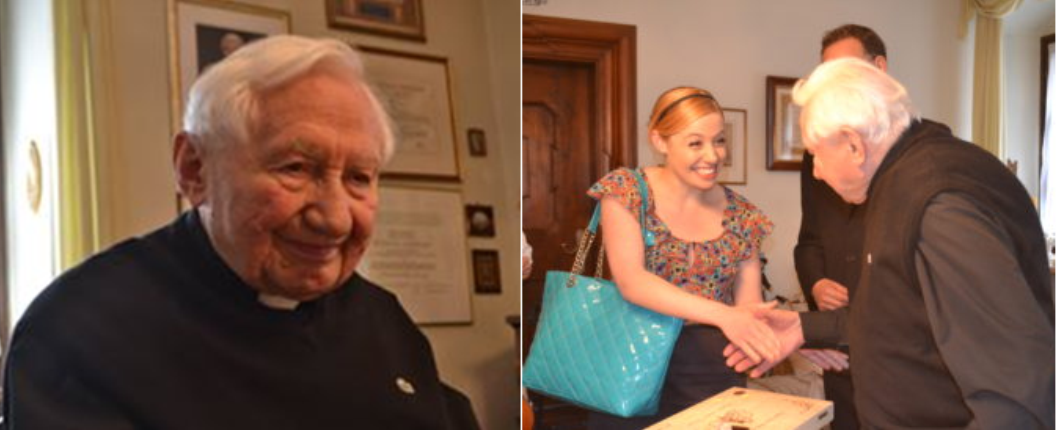

An irony, that hit those participating, was how Joseph Ratzinger, for a long time, was just “the little brother of the famous choir leader, Georg Ratzinger.”
When all three were ordained, the famous one was Father Berger, since he was the mayor’s son.
Until Joseph became cardinal and was called to Rome, even as archbishop of Munich and Freising, he still stood “in the shadow” of his world-famous brother.
[One of the headlines announcing his appointment to Munich actually read, 'Regensburg choirmaster's brother is the new Archbishop'.]

In Regensburg, we also visited the home Prof. Ratzinger had built in 1970 and where he lived till 1977 when he was named Archbishop of Munich-Freising.

Do you know where Pope Benedict’s favorite image of the Madonna is? The answer: in a Marian shrine, known as a place of miracles in the charming-beyond-words town of Altoetting where the Ratzinger family, including little Joseph, and his siblings Georg and Maria, would visit at least once a year.
In this place in 1489, two little boys who had been killed, one in a farm accident and another drowning, had been brought back to life after they were brought before the beautiful image of the Virgin Mary of Altoetting.
In fact, today, this place leaves an impression due to all the trinkets (ex-voto) left on the walls outside the shrine as signs of gratitude for miracles that occurred through Mary’s intercession. (Lighting candles is the gesture one does for obtaining miracles, while an ex-voto represents a sign of a miracle received.)
Throughout and surrounding this shrine, there is not actually enough space on the walls to accommodate all the tributes. The wealthy gave items of silver to show their thanks, whereas the less well off and even very poor people, often drew little pictures to show their gratitude. One sees pictures of hospital beds, or even body parts to reflect recovery of the ill, as well as pictures of babies – even photographs from a few months ago — for babies who were delivered safely after complications, or of parents who couldn’t have children, and then all of a sudden found themselves expecting. Moreover, there are painted images of people who were saved from torturous situations in times of war, struggle, or even recent tsunamis, whose survival was attributed to Mary’s intercession.
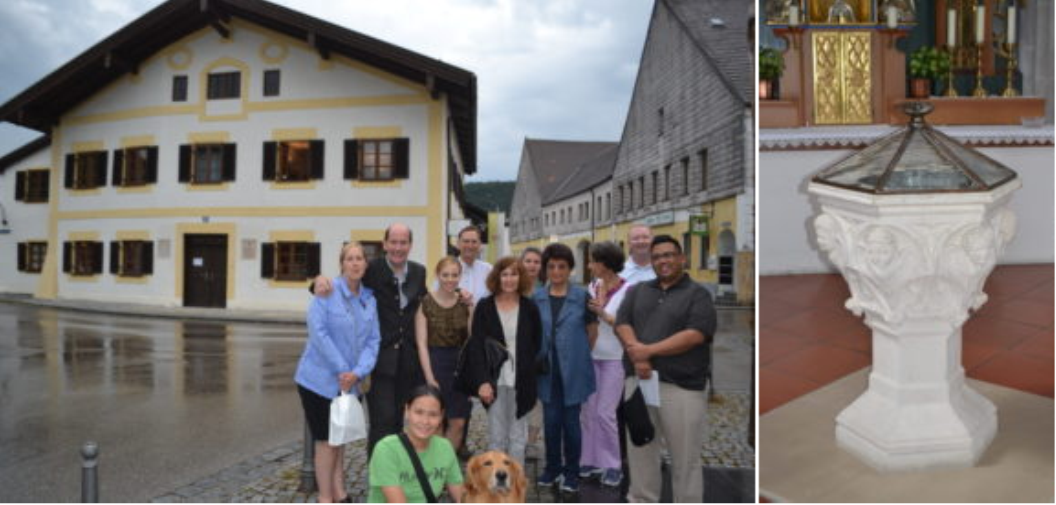
The home in Marktl am Inn is where Joseph spent his earliest years — he was two years old when he and his siblings crossed the street to look at the Christmas decorations of a small department store just opposite their parent’s home. The apple of the little one’s eye: a teddy bear in the window. Every day, little Joseph would watch and admire. But then one day right before Christmas: tears. Why? The teddy bear was gone… . In Germany, litlte ones get their presents after Holy Mass on December 24th. At this moment, little Joseph’s source of sorrow was removed, when instead he experienced great joy as the teddy bear was under the family’s Christmas tree.
“I promise I’ll be good” was written in his Christmas list at the age of seven. (A promise Joseph Ratzinger certainly kept.) In exchange for his good behavior, the three things he requested very articulately: a vestment for when he would play Mass with his brother Georg, the Mass missal translated into German so he could understand the Latin, and a specific image of the Sacred Heart.
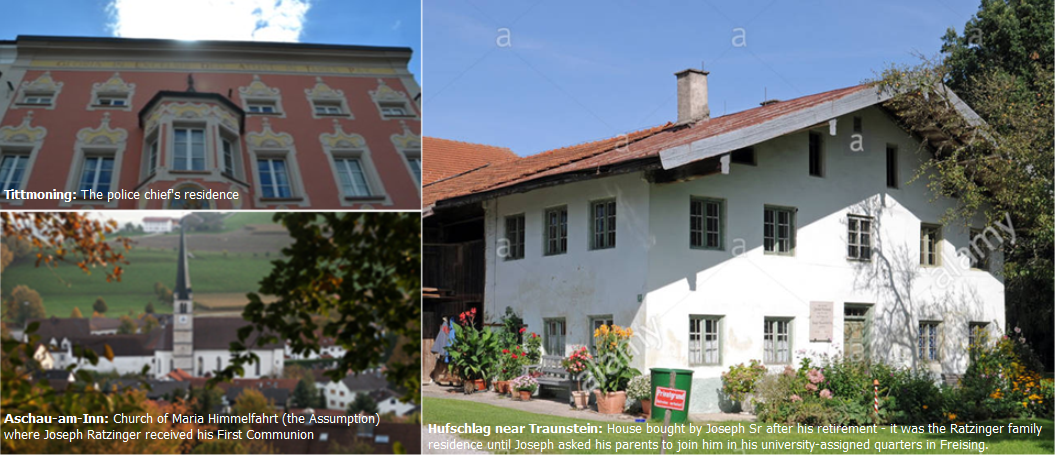
Tittmoning, a small town on the Salzach River, on the Austrian border, where the Ratzinger family lived from 1929-1932, (until about the time that Joseph entered kindergarten), is the place Benedict described as the ‘wonderland' of his childhood. Before going to school, he would stop and pray in church. Here, he began to appreciate the Mass more and more, especially as he observed his older brother serve and his parents sing in the choir.
Also, in this town, where young Joseph began to fall in love with the liturgy, is a Marian Shrine, where he, with his mother and siblings, daily used to go to pray the rosary. We pilgrims braved the steep way up, but it was more than worth it. On the way back, we passed the rapids of a small river running downhill through a forest, giving shade in the summer.
We also visited Auschau am Inn, at the foot of the Alps, where the family had to relocate in 1932, due to Mr Ratzinger’s outspoken criticism of Nazism. Benedict’s family, especially his father, a policeman, always did everything they could to resist the Nazis and keep the family as distant from them as possible. Even this move to Auschau was done so that if soon there would be war, the family could have a home that supplied them with natural resources and food to live on.
In this home, Joseph was often found in solitude reading, his passion, and was a regular reader of
Der gerade Weg (The straight way), the most outspoken Catholic Anti-Nazi publication. After Hitler rose to power, its editor, Fritz Michael Gerlach, was arrested and died in the Dachau concentration camp as a martyr; his beatification process started in 2009. Mr Ratzinger always said no to any Nazi offers. The only thing he allowed was his wife to be part of a women’s group which prayed the rosary.
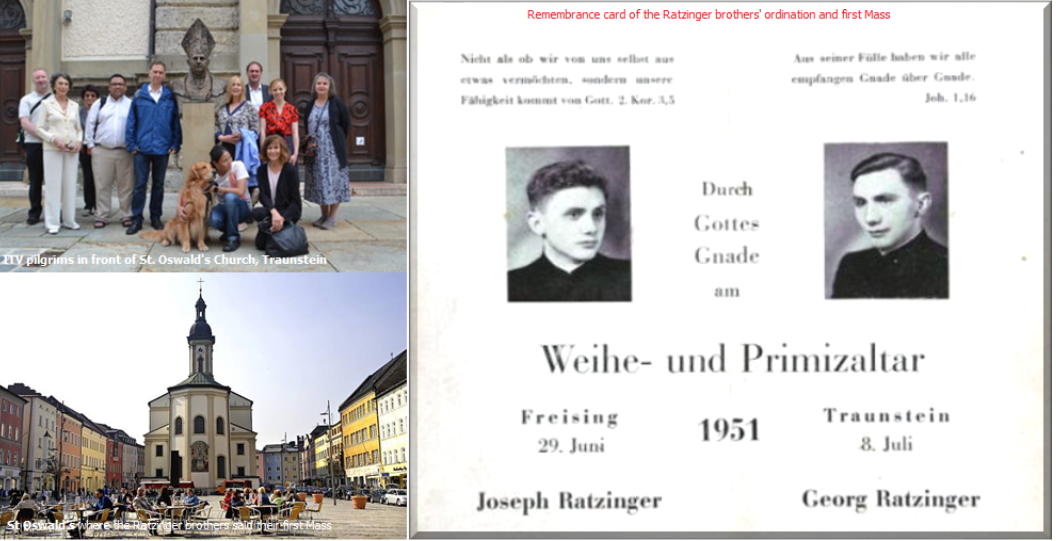
The priests on the pilgrimage had a beautiful moment concelebrating Mass in the Church in Traunstein where Benedict celebrated his first Mass, after having been ordained in Freising.
It was an interesting story how we came to have this Special Mass on a Sunday. While in Rome, during the Mass of Saints Peter and Paul, Robert Moynihan and Deborah Tomlinson of
Inside the Vatican found themselves — completely by chance – seated next to the pastor of the parish in Traunstein. The Pastor of St. Oswald’s told them to come instead on Sunday to Traunstein, rather than Saturday, which was the original plan, so that after the Mass, he could show the group different sites — such as where Pope Benedict’s parents spent their last days – and we could have a nice Bavarian lunch together. At this restaurant, historian Michael Hesemann, who is close to the Ratzingers, shared yet another personal detail he knows well, a delicious one.
The German author ordered “Kaiserschmarrn,” a sweet dish he said is Pope Benedict’s favorite. Another gastronomic surprise was trying the white sausages, which apparently, even now, Benedict enjoys in the Vatican, often brought by his brother or by his personal friends from his time in Bavaria.
Another touching moment was learning about Joseph Ratzinger’s close relationship with his sister, Maria, who was at times like an assistant to him, not to mention also housekeeper and personal secretary. Despite being an accomplished professional, she was happy to instead dedicate her time to performing many tasks that would have taken away from his scholarly endeavors.
The small group participating also looked at the richness of the works and discourses of Ratzinger and later Pope Benedict, through interactive discussions led by Robert Moynihan, Vatican expert and founder and editor-in-chief of
Inside the Vatican magazine, to enrich their understanding of the Pope Emeritus.
Those participating also enjoyed various other memorable Bavarian moments, along with time for free exploration, eating well, and time of reflection. For instance, we visited the Weltenburg Monastery, on the beautiful Danube River, which brewed the first Bavarian beer a thousand years ago – and still continues to operate - and which served as a retreat for Professor Joseph Ratzinger and his doctoral students during the years when he was a professor in Regensburg.
There was also a very moving visit to Augsburg to see Mary, Untier of Knots, who is so important to Pope Francis that he has made sure she is in Santa Marta; as well as a fun stop at Neuschwanstein Castle, which was the inspiration for the castle in Disneyland.
All in all, this journey, retracing Joseph Ratzinger’s footsteps, and meeting many of those involved in Ratzinger’s journey from the past through the present, between Rome and Bavaria, has left — as the pilgrims all expressed — an impact for them that they will never forget….
Almost all the photos on this spread were taken by Michael Hesemann. I supplemented a few - like adding photos of Aschau-am-Inn and Hufschlag, or the famous post-ordination photos of the Ratzinger brother with their fellow Traunsteiner, Rupert Berger, who was ordained with them; a photo of Traunstein's St Oswald church; and the Ratzinger brothers' joint remembrance card of their ordination and First Mass (they also had individual remembrance cards.
In Googling Marktl, I came across this touching and most unusual way that Benedict XVI's 91st birthday was celebrated today. From the site of the Benedikthaus in Marktl:
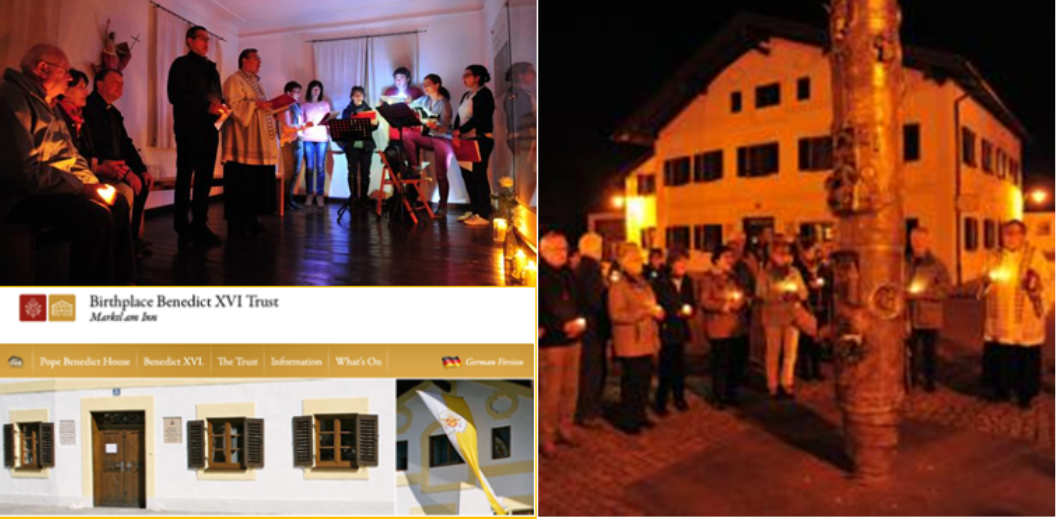
At 4.15 in the morning today [the hour at which Joseph Ratzinger was born 91 years ago], 50 wellwishers from Marktl and nearby places gathered in the Birth Room of the Benedict XVI house museum to praise and thank God with prayers and solemn songs for Joseph Ratzinger and his life in the service of God and the Church.
Afterwards, they went in a candlelight procession towards the parish church where baby Joseph had been baptized on Holy Saturday, 16 April 1927, just over 4 hours after his birth. They made a prayer stop at the socalled Benediktsaule (Benedict pillar), a bronze column with scenes from Ratzinger's life in bas relief. [This was installed during Benedict XVI's visit to Marktl in September 2006.]
At the church, the wellwishers used the opportunity to think of their own baptism, crossing themselves with holy water from the baptismal font where the baby Joseph was baptized with the just-blessed Easter water.
Afterwards there was breakfast for everyone in the parsonage.
I would be remiss if I didn't go on record even if one day late on the birthday tributes of Fr Hunwicke and Aldo Maria Valli, respectively (Valli's I have yet to translate, but as usual, he takes one of Benedict XVI's homilies, seemingly at random, but which somehow manage to get to the core of many of the needless 'perplexities' bedevilling and fracturing the Church today, though Benedict XVI himself probably never imagined that this disunity would be brought about by the man who would succeed him as pope (a logical impossibility given that the pope, whoever he is, is supposed to be the visible symbol of unity in the Church, not the principal agent of disunity as Bergoglio is.)
Ad multos annos plurimosque annos ...

April 16, 2018
Today is the birthday of Joseph Ratzinger, sometime Bishop of Rome, and the anniversary of his rebirth in Baptism on the day when the Church was celebrating her Passover.
His pontificate was short, but what enrichment it brought us. The
vetusta Novitas of the Bible, the Fathers, and the Liturgy; Summorum Pontificum and Anglicanorum coetibus; the beatification of Newman - how much grace we received in those years through his gentle and generous hands.
It turned out to be a necessary stocking-up of the larder with good and nourishing food; food destined to be our rations during the winter and the ice and the time of tears and cruelty. As we warm ourselves at our hearths today, and hear the wolves still howling outside as they run licensed and unconfined, hungry and increasingly desperate, memories of the good times reassure us that, in the power of the Spirit, and if we keep faith, good times can return.
Veni Sancte Spiritus ... flecte quod est rigidum, fove quod est frigidum, rege quod est devium. (Come, Holy Spirit...Bend that which is inflexible, warm that which is chilled, correct what goes astray).
[From the beautiful 'Golden Sequence' prescribed in the Roman Liturgy for the Masses of Pentecost and its octave, usually attributed to either the thirteenth-century Pope Innocent III or to the Archbishop of Canterbury, Cardinal Stephen Langton. It is one of only four medieval Sequences which were preserved in the Missale Romanum published in 1570 following the Council of Trent (1545–63). Before Trent many feasts had their own sequences. It is still sung today in some parishes on Pentecost.]
And there are at last sounds of the glaciers cracking, and of the trickle of tiny streams running out from beneath the compacted ice ... and the sight of little buds beginning to open beside the streams.
In a manner of speaking, we might say that Pope Benedict's glorious pontificate is still alive among us, since it is to the sinewy strength of his biblical and patristic teaching, and to the structures he left in place, that we continue to turn as we look to the return of the Maytime, when "The happy birds Te Deum sing, 'tis Mary's month of May."
In a justly famous sermon, Blessed John Henry Newman addressed to our Lady some words derived from the Song of Solomon:
"Arise, make haste, my love, my dove, my beautiful one, and come. For the winter is now past, the rain is over and gone. The flowers have appeared in our land. ... The fig tree hath put forth her green figs; the vines in flower yield their sweet smell. Arise, my love, my beautiful one, and come. It is time for thy Visitation. Arise, Mary, and go forth in thy strength ..."
May the prayers of our Mother gain for us the grace of perseverance in this last dark hour of the apostasy. Was there ever a tyranny which lasted for ever, or an eternal winter?
She will go forth in her strength.
Her Immaculate Heart will prevail.
formed.org/watch/58cc4c2e08a8e56c0cab1ef2
Here, from ROME REPORTS is yet another documentary on Benedict XVI - made while he was Pope - that I am seeing for the first time. It is entitled BENEDICT XVI: A LOVE AFFAIR WITH THE TRUTH, about the man who most likely 'co-wrote' John Paul II's great encyclical on the splendor of truth, Veritatis splendor, a rebuke to all who manipulate the truth in any way and in doing so, violate it.
Everything in the documentary evokes the blessed continuing wonder that characterized pope watching in those days. Every event shown in the video continues to be as moving and wondrous as it was at the time it occurred. (But I must say I find it hard to have John Allen as the principal commentator in the video, though he certainly sounds enthusiastic about his subject - apparently, he was chosen because he had written a biography of Joseph Ratzinger, not very flattering the first time around, but re-published and 'purified' as it were after his subject became Pope - with some assist from Paul Badde, who should have been 'used' much better.) A
And a rather creative and entertaining video about our beloved many-splendored pope...
I find that most people in the media, and even many of the best commentators on Church affairs who like and admire Benedict XVI, seem to have an exaggerated recollection of the 'opposition' to his papacy. When there really wasn't very much of it, and certainly not in the sense of the opposition there is to his successor. The opposition to Benedict XVI was always mainly in the media. His ideological opponents have remained the same ones over the years and always had merely peripheral significance because they were playing against someone who was always so far above and beyond their league so that they were at most gadflies who could easily be swatted down.
Almost like the myth of the Panzerkardinal/God's Rottweiler that surrounded Joseph Ratzinger's 23 years as the official defender of the faith is the myth of the crisis-beset pope who in the end found himself unable to continue with the superhuman task of being Christ's Vicar on earth (and is now continuously mocked and spat upon by the Mundabors, De Matteis, Verrecchios and Canon212s of the world for having 'fled the wolves)].
In fact, the 'crises' of his pontificate were few and far between - and certainly, not all negative or scandalous in the ecclesial or secular sense: Regensburg and Summorum Pontificum, for example, for all the controversy they generated, were seminal and emblematic acts of his pontificate - the first one for its celebration of faith and reason, the other for its celebration of liturgy as our supreme act of worship towards God. And it wasn't as if the controversy went on and on.
At the time, I remarked how amazing it was that for all the fire and fury that the Regensburg lecture aroused in the Muslim world and in Catholic critics of Benedict XVI, the entire controversy really lasted just about two weeks in the news, after which it was softened and redeemed in its true worth by first the unexpected positive reaction of the 130 Muslim scholars to it, and then, six weeks after the lecture, by the almost miraculous success of his trip to Turkey, which had been the seat of the most furious attacks on the Regensburg lecture and Benedict XVI himself, a hostility which he turned around overnight by his visit to the Blue Mosque that won over even Turkey's most militant media.
As for Summorum Pontificum, it is a gift that goes on giving, for every brick added daily to rebuild the liturgy back to what the Fathers at the Council of Trent meant it to be, an indispensable affirmation of the Counter-Reformation.
Other 'crises' were relatively minor and manufactured. Two were related, in that both involved bishops, in both of which incidents it turned out that the Vatican offices meant to prevent such embarassments from happening simply failed to exercise the due diligence they were supposed to bring to bear.
The first had to do with the nomination of Mons. Wielgus to be Archbishop of Warsaw, when it was already well-known in Poland that he was identified in the secret archives of the Communist regime to have been an informer on other priests; the second, on the fact that one of the four Lefebvrian bishops whose excommunication Benedict XVI decided to lift, was unmasked in a Swedish TV documentary timed to sabotage the Vatican announcement, as a Holocaust denier.
Of course, Mons. Williamson's mistaken opinion on historical fact had nothing to do why he was excommunicated to begin with, but many in the Church, bishops included, used the occasion as a pretext to put blame and shame on Benedict XVI, promptly magnified and amplified by the media.
It occasioned, however, one of the most extraordinary moments in the history of the pontificate - Benedict XVI's letter to the bishops of the world, apologizing first for the Vatican's obvious lack of information about Williamson (both the Congregation of Bishops and Ecclesia Dei failed miserably here, where with Wielgus, it was the Secretariat of State and the Nuncio in Poland, along with the Congregation of Bishops, that failed due diligence), and then going on to explain the full context of why he lifted the excommunications, and why the Church cannot afford to continue ignoring the FSSPX and its special charisms. A historic unprecedented letter that read like a Pauline epistle, and one of the largely unacknowledged great documents of his Pontificate. (And how absurd that some Bergoglians are comparing the current pope's letter to the Chilean bishops apologizing for his mistakes in prejudging the Barros case to Benedict XVI's letter!)
But then there was the continuing backdrop to the media's presentation of Benedict XVI - whom they irrationally came to blame for the entire clerical sex-abuse scandal in the Church, when he was the one person who had first acted proactively to put a stop to it and bring some healing and comfort to the victims while bringing their abusers to justice.
New revelations of widespread abuses in Germany and Ireland, in particular, were all laid on Benedict's head to a point where in 2009-2010, three of the world's most powerful media giants (AP, the New York Times, and the Spiegel group in Germany) brought all their considerable resources to bear in order to tie Joseph Ratzinger directly to a case of sexual abuse (the best they could do was to link his brother to one such major case in Regensburg) or of a major cover-up thereof. Nothing credible came out of their huffing and puffing which, it seemed, was intended to constrain him to resign! And so, that highwater tide of media pressure eventually ebbed. Only to rise again with the so-called Vatileaks in 2012.
And like the luridly imagined delusion of seeing Joseph Ratzinger himself sullied by the filth of the Church he had so often denounced, the media imagined and projected the image of 'the scandal of the century' over the petty and picayune revelations of behind-the-scenes bureaucratic wrangling at the Vatican from the few and random documents that the pope's valet pilfered from the pope's desk.
Yet the media found not one of those petty incidents even worthy of investigating - and since when have the media been shy about investigating scandal? It was obviously because like the Ratzinger-the-covert-sex-abuser scenario, or at least, Ratzinger-the-great-protector-of-abusive-priests, that the media giants tried to uncover, there never was any there there in any of the Vatileaks trivial tidbits, titillating as the media made them out to be. Even if, as the author of the Vatileaks book himself pointed out from the start, none of the documents implicated Benedict XVI himself in anything questionable, let alone scandalous or criminal!
And yet the media managed to turn the offended party and victim in this case - the pope whose private papers were purloined - into an indicted co-conspirator, so to speak, in any scandals they implied but never elaborated on nor investigated because no, there was never any there there!
I did not realize the diabolical effects of the media treatment of Vatileaks until all the talk by the cardinal electors before the 2013 Conclave, which appeared to have been fueled primarily by the image of the Benedict XVI pontificate they had derived from the Vatileaks reporting! Namely, Vatileaks had shown them that the greatest problem faced by the next pope was the reform of the Roman Curia!
It was unbelievable how some 120 cardinals, many of whom, on the basis of their CV and career achievements, truly represented the best and the brightest in the Church, could have so completely swallowed the great Vatileaks hoax perpetrated by the media, as to consider bureaucratic inefficiency and incompetence as the major problem of the Church, and not the continuing decline of faith even and especially among Catholics. And with the same incredible gullibility, to buy the Sankt Gallen Mafia's electioneering in behalf of Jorge Bergoglio as the answer to that problem. They were not electing a pope but the CEO of what would soon become, for this CEO, nothing more than the largest NGO in the world, headed by someone with as little credentials to be pope as to be a CEO.
[Modificato da TERESA BENEDETTA 21/04/2018 07:07]